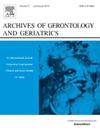The influence of the built environment and perceived neighborhood on physical frailty and sarcopenia in older adults: A systematic review
IF 3.5
3区 医学
Q2 GERIATRICS & GERONTOLOGY
引用次数: 0
Abstract
Objective
To examine the scientific evidence on the relationship between the built environment, perceived neighborhood, and physical frailty and sarcopenia in older adults.
Methods
The search used PUBMED, SCOPUS, EMBASE, Web of Science, Scielo databases, and Google Scholar as gray literature. Studies with non-institutionalized older adults aged 60 years or older that tested the relationship with the perceived neighborhood and built environment and with physical frailty or sarcopenia, as well as observational studies published in English, Portuguese, and Spanish, were included.
Results
18 studies were included in the qualitative synthesis (n = 102.789 older adults). Three studies evaluated the relationship between the built environment and perceived neighborhood and sarcopenia, and 15 studies with physical frailty. Regarding the study design, five studies were cohort, and 13 were cross-sectional. The results found that lack of access to public transportation, poor access to recreational facilities, absence of destination, hazard hills, and absence of traffic safety were risk factors for sarcopenia. Walkability, safety from crime, recreational facilities/walking and cycling facilities/exercise facilities and neighborhood aesthetics, were environmental characteristics that showed associations with physical frailty. After sensitivity analysis, walkability was shown to be inconclusive.
Conclusion
Evidence indicates that older adults who live in built environments with higher walkability, access to recreational facilities/walking and cycling facilities/exercise facilities and neighborhood aesthetics are less likely to develop physical frailty. Current evidence regarding sarcopenia remains limited and inconclusive.
建筑环境和感知社区对老年人身体虚弱和肌肉减少症的影响:一项系统综述
目的探讨建成环境、邻里感知与老年人身体虚弱和肌肉减少症之间关系的科学依据。方法采用PUBMED、SCOPUS、EMBASE、Web of Science、Scielo数据库和谷歌Scholar作为灰色文献进行检索。研究对象为60岁或以上的非机构老年人,这些研究测试了感知社区和建筑环境与身体虚弱或肌肉减少症之间的关系,以及以英语、葡萄牙语和西班牙语发表的观察性研究。结果定性综合纳入18项研究(n = 102.789名老年人)。3项研究评估了建筑环境和感知社区与肌肉减少症之间的关系,15项研究与身体虚弱有关。在研究设计上,5项研究为队列研究,13项研究为横断面研究。结果发现,缺乏公共交通工具、缺乏娱乐设施、缺乏目的地、危险山丘和缺乏交通安全是肌肉减少症的危险因素。可步行性、远离犯罪、娱乐设施/步行和骑自行车设施/锻炼设施和社区美学是与身体脆弱相关的环境特征。经过敏感性分析,可步行性是不确定的。结论有证据表明,居住在可步行性、娱乐设施/步行和自行车设施/运动设施可及性和社区美学较高的建成环境中的老年人发生身体虚弱的可能性较小。目前关于肌肉减少症的证据仍然有限且不确定。
本文章由计算机程序翻译,如有差异,请以英文原文为准。
求助全文
约1分钟内获得全文
求助全文
来源期刊
CiteScore
7.30
自引率
5.00%
发文量
198
审稿时长
16 days
期刊介绍:
Archives of Gerontology and Geriatrics provides a medium for the publication of papers from the fields of experimental gerontology and clinical and social geriatrics. The principal aim of the journal is to facilitate the exchange of information between specialists in these three fields of gerontological research. Experimental papers dealing with the basic mechanisms of aging at molecular, cellular, tissue or organ levels will be published.
Clinical papers will be accepted if they provide sufficiently new information or are of fundamental importance for the knowledge of human aging. Purely descriptive clinical papers will be accepted only if the results permit further interpretation. Papers dealing with anti-aging pharmacological preparations in humans are welcome. Papers on the social aspects of geriatrics will be accepted if they are of general interest regarding the epidemiology of aging and the efficiency and working methods of the social organizations for the health care of the elderly.

 求助内容:
求助内容: 应助结果提醒方式:
应助结果提醒方式:


